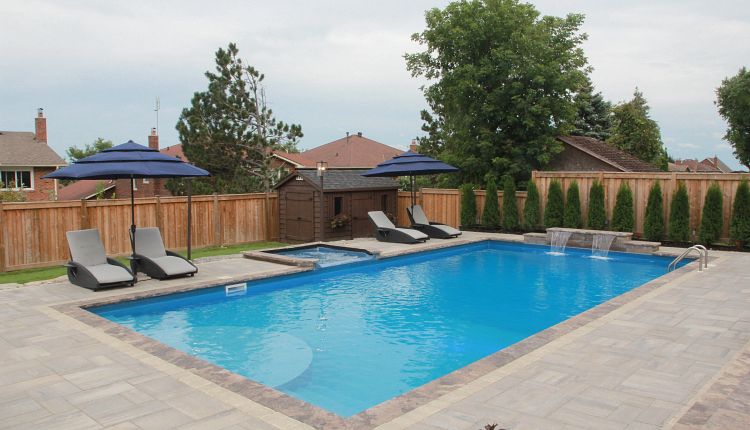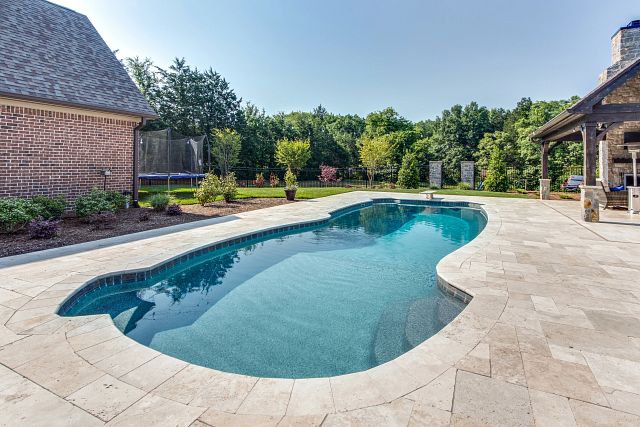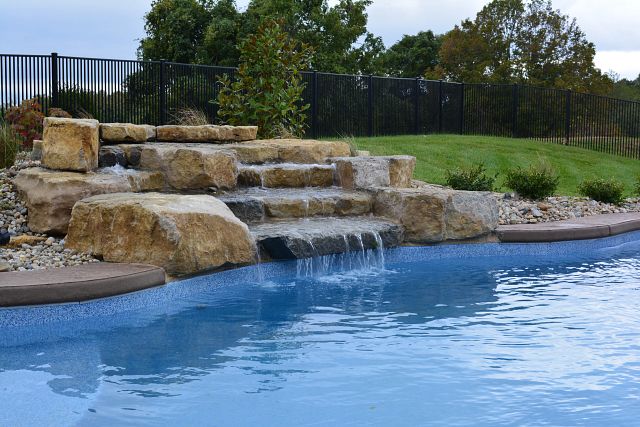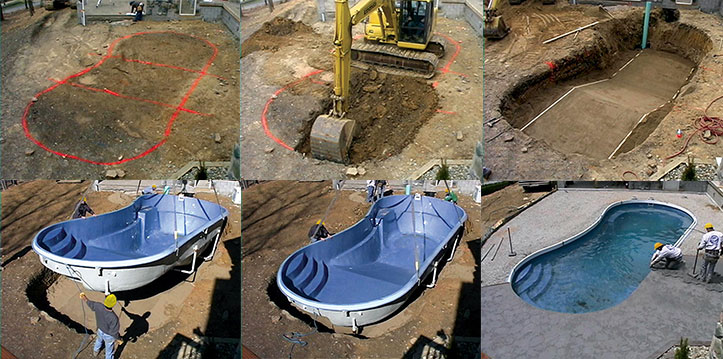Vinyl liner pools are popular among existing and prospective pool owners because of their features and the options they offer for customization. Thanks to long-lasting materials and innovative technology, vinyl liner pools can withstand sunlight, water and chemicals. This means a vinyl liner pool requires less maintenance and upkeep than a concrete pool.
Some ongoing maintenance is recommended to keep your vinyl pool looking like new and functioning properly. In this guide, we’ll go through best practices to help you clean and maintain your vinyl pool liner.
The vinyl liner in your swimming pool is beautiful, strong, and durable, and is designed to last for many years. However, even today’s advanced vinyl liners need to be cared for properly if you want to get the full return on your investment. But, the time and effort needed to maintain a vinyl liner in is really minimal once you get into the habit of running through a short maintenance checklist.
How to Clean A Vinyl Pool Liner
Here are the things you should do on a regular basis to clean and extend the lifespan of your vinyl liner:
- Gently brush it. To keep dirt, debris, and undissolved chemicals from accumulating on the liner, give it some attention with a soft-bristle brush or sponge periodically. How often depends on how much foreign material ends up in your pool, but you might start with once per week.
- Maintain proper water chemistry. If your pool water is not in balance, it can have a negative effect on your liner. From calcium scaling to wrinkling and puckering to accelerated aging, there are a whole host of issues that can arise. However, maintaining proper water chemistry is easy once you learn how.
- Prevent chemicals from coming in contact with the liner. As you add chemicals to keep your water in balance, be sure you do so in a way that prevents them — especially chlorine crystals — from coming to rest on the liner. That interaction can cause bleaching and deterioration. Be sure to completely dissolve your chlorine or shock in a bucket before putting it into the pool.
- Never empty your vinyl liner pool. Your liner can shrink and crack if you completely empty the pool. If you need to drain some of the water for any reason, be sure you don’t remove more than half of the total volume.
- Tend to the waterline. Dirt and oils can build up at the waterline and cause staining. Use a vinyl liner cleaning solution to keep the area at and above the waterline clean. This kind of product will also help protect the liner from the sun’s damaging rays.
- Don’t allow toys that aren’t pool-safe. Pool toys are designed to be free of corners and sharp edges for a reason. Objects with those characteristics can puncture or tear a liner. Be sure that you only allow appropriate toys in the pool.
How to Clean Pool Liner Stains
Cleaning pool liner stains will help you keep your vinyl liner looking like new. Before you start the process, it’s important to identify the type of stain and the underlying cause. Most vinyl liner stains are organic or metal:
- Organic stains: Generally brown or green in appearance. Caused by weather and other factors like dirt, algae and leaves.
- Metal stains: Metal stains are usually caused by hardware or equipment in your pool like ladders and heaters.
- Waterline stains: Often described as a “ring” around your pool and is often caused by undissolved pool chemicals or calcium buildup.
We always recommend contacting a pool professional for cleaning and maintenance, they can help you remove tough stains and ensure you don’t use any products or chemicals that may damage the pool liner. To clean pool liner stains, follow the same steps as above. To recap:
- Remove dirt and debris
- Vacuum pool and clean the pool filter
- Gently scrub pool liner with a soft-bristle brush
- Balance the water chemistry
- Shock your pool
What to Use to Clean Pool Liner
It’s important to contact your pool manufacturer before using any chemicals or other materials on your pool liner. While there are many DIY cleaning solutions online, do not use these unless you have spoken to a professional. In general, contact a professional before performing any maintenance on your own.
How to Get Wrinkles Out of Pool Liner
Another important part of vinyl liner maintenance is keeping the liner free of wrinkles. Wrinkles can occur for a number of reasons, from improper installation to water chemistry problems. But, once the underlying problem is resolved, there are a number of things you can do to get wrinkles out of your pool liner:
- In bare feet or while wearing soft-soled shoes, walk along the pool floor gently spreading the wrinkles with your feet. Sometimes pushing the edge of a wrinkle toward the nearest wall is effective.
- Use a plunger to pull the liner material in the appropriate direction to remove the wrinkle.
- Warm the water. Wrinkles are more likely to form and harder to remove the colder your pool water is. Cranking up the heater a bit can make wrinkle removal (and prevention if you choose to stay at the higher temperature) easier.
- Check for leaks. Small leaks in your liner can cause wrinkles, as well as other problems. Find and patch any leaks before attempting to address wrinkles.
- Get help from a pool professional. If you have a persistent problem with wrinkles, you may want to consult a professional.
Vinyl Pool Maintenance
Besides understanding how to clean a vinyl pool liner, you should also have a general understanding of the minimal ongoing maintenance to help keep your vinyl liner pool in pristine condition. Here, we’ll go over how to protect your liner and how to keep your vinyl pool liner from fading.
How to Keep Vinyl Pool Liner From Fading
Taking certain steps to prevent fading can preserve the color and keep your vinyl liner looking vibrant.
Here are some best practices to keep your vinyl pool liner from fading:
Invest in a Pool Cover
Solid and mesh pool covers can block sunlight from your pool which can prevent fading and help you save money on pool chemicals and maintenance costs. Solid and mesh winter pool covers are easy to install and keep dirt, debris and unwanted materials out of your pool when it’s not in use.
Avoid Using Harsh Chemicals on Your Vinyl Liner
Again, it’s imperative that you check with your pool manufacturer before using chemicals or solutions on your vinyl liner. This can help prevent fading and other types of damage.
Balance the Water Chemistry
If your water chemistry is out of balance, it can lead to stains from too many chemicals or potential algae growth. Make sure to check your water chemistry and balance your water regularly.
How to Protect a Pool Liner
Protecting your pool liner is important to ensure your pool works properly and that you can enjoy your backyard oasis for years to come. Besides the cleaning and maintenance tips we shared above, follow these guidelines to protect your vinyl pool liner:
- Never drain your pool completely: Draining your pool can actually cause your vinyl pool liner to shrink and cause unsightly wrinkles or tears. If you need to drain water from your pool, we recommend contacting a professional.
- Check the water line and watch for leaks: Monitoring your pool’s water line is one of the easiest ways to check for leaks. The area around the water line is prone to stains and fading. Make sure to clean this area regularly using a soft sponge.
- Don’t use unauthorized materials or chemicals on your pool liner: Again, make sure to contact your pool manufacturer before using any chemicals or solutions.
Contact Us for More Vinyl Liner Pool Maintenance Tips
If you’ve got questions about how to get the most out of your vinyl liner, contact your local independent Latham Independent Builder for more information.







Join the discussion